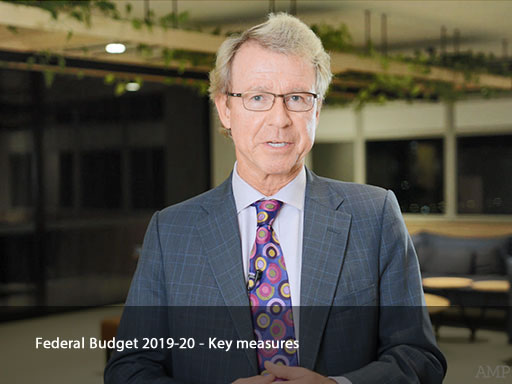Grow My Wealth | 03 April 2019
Find out how the measures announced in the 2019-20 Federal Budget could affect you
Federal Treasurer Josh Frydenberg has handed down the Morrison Government’s first Federal Budget. Among the proposed changes were personal income tax cuts and changes to super rules.
Read on for a round-up of the proposals put forward and a look at how they might affect your household expenses and financial future, whatever your stage of life.
Remember, at the moment these are just proposals and could change as legislation passes through parliament.
Tax
Personal income tax cuts
The government is proposing to expand the personal income tax cuts that have been legislated from the 2018-19 budget. These tax cuts will particularly benefit low-to-middle income earners.
The indicative tax cuts in 2018-19, compared to 2017-18, are as follows.
Reduction in tax paid – individuals
These cuts will be achieved through a combination of changes to tax offsets, adjustments to personal income tax brackets and marginal rates.
Changing tax thresholds and marginal tax rates
- From 1 July 2022, the top threshold for the 19% marginal tax bracket is proposed to increase to $45,000.
- From 1 July 2024, the government proposes to reduce the current 32.5% marginal tax rate to 30%.
Increasing the Low and Middle Income Tax Offset (LMITO)
- For the 2018-19 to 2021-22 tax years, the LMITO will increase to provide tax relief of up to $1,080 per year to low and middle income earning Australians.
Increasing the Low Income Tax Offset (LITO)
- From 1 July 2022, the LITO is proposed to increase to $700.
New proposed personal tax rates and thresholds
Effective tax-free threshold 2018-19
LITO and LMITO (Individuals below Age Pension age) – $21,884
Increasing and expanding SME access to the instant asset write off
The instant asset write-off threshold is increasing from $25,000 to $30,000. The threshold applies on a per asset basis, so eligible businesses can instantly write off multiple assets.
Small businesses (aggregated annual turnover of less than $10 million) will be able to immediately deduct purchases of eligible assets costing less than $30,000 that are first used, or installed ready for use, from budget night to 30 June 2020.
Medium sized businesses (aggregated annual turnover of $10 million or more but less than $50 million) will also be able to immediately deduct purchases of eligible assets costing less than $30,000 that are first used, or installed ready for use, from budget night to 30 June 2020.
However, medium sized businesses must also acquire these assets after budget night to be eligible.
Super
The government has proposed a number of measures to make it easier for Australians aged between 65 and 67 to top up their super.
Super contribution work test to apply from age 67
Currently, people aged 65 to 74 must be in paid work for a minimum of 40 hours in any consecutive 30-day period in the financial year to make voluntary super contributions.
From 1 July 2020, this ‘work test’ will only be necessary where contributions are made by people aged 67 to 74.
This proposed change means that people aged 65 or 66 who don’t meet the work test because they, for example, only work one day a week, or do volunteer work, will be allowed to make voluntary concessional and non-concessional contributions to their super.
Age limit for ‘bringing forward’ non-concessional contributions increasing to 67
The government is proposing to extend the ‘bring-forward’ rules which allow Australians aged less than 65 at the start of the financial year to make up to three years’ worth of non-concessional contributions to their super in a single financial year.
From 1 July 2020, the bring-forward rules will be extended so they also apply to people aged 65 and 66 at the start of the financial year.
Age limit for spouse super contributions increasing to 74
Currently, Australians aged 70 years and over cannot receive contributions made by their spouse on their behalf. The government is proposing to increase the age limit for spouse super contributions from 69 to 74 years from 1 July 2020.
Spouse super contributions are counted towards the receiving spouse’s non-concessional contribution cap. It is expected that the receiving spouse will need to continue to meet the work test from the work test age (please see above).
Medicare levy changes
While the Medicare levy remains unchanged at 2% of taxable income, the thresholds for low-income singles, families, and seniors and pensioners will increase in the 2018-19 income year.
The threshold for singles will increase to $22,398. The family threshold will increase to $37,794 plus $3,471 for each dependent child or student.
For single seniors and pensioners, the threshold will increase to $35,418. The family threshold for seniors and pensioners will increase to $49,304 plus $3,471 for each dependent child or student.
Social security
Help with paying energy bills for Australians on income support
Individuals in receipt of a qualifying income support payment will receive a one-off Energy Assistance Payment of $75 for singles and $125 for couples (combined) to assist with energy bills.
Qualifying payments include the Age Pension, Disability Support Pension, Parenting Payment Single, Veterans’ Service Pension, Veterans’ Income Support Supplement, Veterans’ disability payments, War Widow Pension, and permanent impairment payments under the Military Rehabilitation and Compensation Act 2004.
Aged care
The government has allocated $320 million for a one-off increase to the basic care subsidy for aged care residents.
Also, 10,000 extra home care packages will be released over the next five years.


